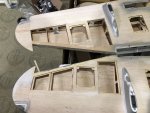struggleforlife
Member
You're quite the magician with the designing stuff, aren't you!?
The abs came out good, looks great as always.
The abs came out good, looks great as always.
































So really what's left on the wing?
Obviously the balsa sheeting needs completion. That should not take long and blending in as well. I'll apply spackle to the joints as well as the edges of the pylons to blend those as well.
I need to fabricate fiberglass secondary gear door covers for the inside. Another detail I wish Hangar 9 had included. But it's two more servos, 4 more hinges, and more moulded fiberglass to do it. Not to mention possibly a sequencer for the ARF. I'll use a separate channel on my Horus and add delay. With this part, I'm thinking I'll do the same as my tail gear doors but I'll add a second finishing layer. I'll also try and be more careful with planning and put the glass more on a 45-degree bias for better strength. This part is bound to see more turbulence. After that I can cut the hole for it in the wing, add some hinges and a servo and get the gear installed for exact fitting and cutting.
Maybe I can do all this this week... maybe not, but let's find out.





